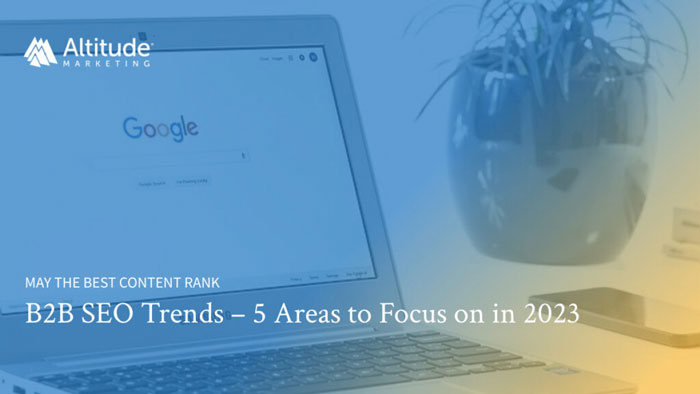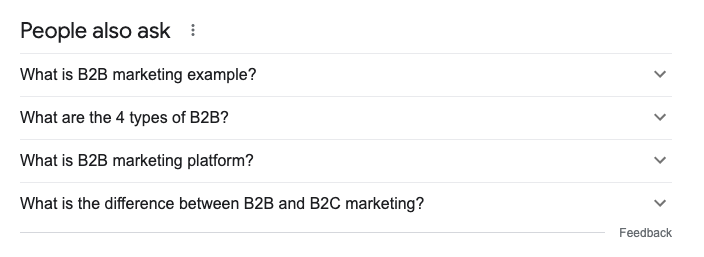Everyone wants to stay ahead of the competition – especially, let’s face it, on Google. In the world of B2B SEO, that page one ranking can lead to qualified leads pouring through the door. To keep pace, here are five B2B SEO trends to focus on.
Before we dig into the trends, a little background.
The conversation around SEO can quickly devolve into a discussion around tips and tricks, tactics and technical jargon. These terms only serve to muddy the waters and divert people’s attention and efforts towards “gaming” Google’s algorithm.
Ultimately, this approach will fail. Google is the smartest “machine” ever created. And it’s incentivized to provide the best user experience possible.
If your content isn’t good, if your site isn’t user-friendly, you won’t rank. (Google itself says so.)
The best way to approach SEO is through an integrated approach of creating the best content possible and serving that content up on a site that performs flawlessly.
With that in mind, let’s look at the B2B SEO trends for 2023.

B2B SEO Trends for 2023
- Search Intent
- EAT (Expertise, Authority, Trustworthiness)
- Expanded SERP Features
- Core Web Vitals
- Mobile Usability (AMP is dead)
#1 – Search Intent
Every time you search for something, you want something. This is the thought behind search intent.
As Google has grown more sophisticated, it’s able to determine what a user actually wants when searching a certain term. With that knowledge, the algorithm can determine the best content that meets the intent behind the search.
Google uses three broad categories of search intent.
- “Buying” Search Intent: when a user is searching for something with the intent to buy. For terms with buying intent, Google will show eCommerce results.
- “Informational” Search Intent: when a user is searching a term to research a topic. For terms with informational intent, Google will show articles, and most likely, Wikipedia will be near the top.
- “How-To” Search Intent: when a user is looking for how to do something. For these terms, Google will show articles that answer the question.
It’s not enough just to have a list of keywords. You need to know the search intent behind each if you want to rank well.
A simple way to determine search intent for your relevant keyword is to Google them. See what pops up and create content that matches what’s on the first page. If content like yours does not pop up, then you’ll have to consider other terms or go back to the drawing board.
Also, don’t fool yourself into thinking you’re creating the content that people actually want. For most search terms with measurable monthly volume, Google knows and is showing the users what they want to see.
As good as your content might be, if it doesn’t match the intent, it won’t rank well.
#2 – E-A-T (Expertise, Authority, Trustworthiness)
An offshoot of search intent is what Google calls E-A-T, or Expertise, Authority, and Trustworthiness.
E-A-T is the metric that Google uses to evaluate the overall quality of a webpage. Anyone can create a website and post content. What Google is trying to do with E-A-T is ensure that it’s returning results from trustworthy and authoritative sources.
While E-A-T may not play a direct role in ranking a website, there are associated signals Google uses to determine your site’s E-A-T on certain topics.
To increase your E-A-T, creating great content is a start, but to really start to build that authority, you need to share your content, leverage it in digital ads, and get valuable backlinks from other autorotative sources.
#3 – Expanded SERP Features
SERP stands for Search Engine Results Page. While this could be any search engine, we’re focusing on Google specifically. And there are a lot of B2B SEO trends with Google recently.
If you’ve searched for anything on Google lately, then you’ve probably noticed a lot more variety in what shows up on the page. You’ll see things like rich snippets, passage rankings and “people also ask” sections.

These extensions are designed to give people the answer they are searching for as quickly as possible without leaving Google. These SERP features are great for the user, and they can provide a boost in site traffic and awareness for your brand should your content be pulled for one of these features.
That all sounds great, but should you build your strategy around attaining these placements?
Probably not. Here’s why.
They can change frequently. The Google algorithm is always tinkering with these expanded results to provide the user with the best possible answer. Building an SEO strategy around attaining the mythical “position zero” is unwise.
Like we said at first, your strategy around SEO should always be to create the best content possible for the user. If you create the best content for a certain search query, then that content will have a much more permanent spot on page one.
#4 – Core Web Vitals
Core Web Vitals will continue to play a big role in 2023 and beyond.
Core Web Vitals are a set of site performance measurements that are indicative of a website’s overall user experience.
The three Core Web Vitals are:
- Largest contentful paint (LCP): represents how quickly the content of a page is loaded. More specifically, it’s the time it takes to render the largest content element visible on the page. That element could be a large text box, image or video. Ideally, your site should strive to have an LCP of 2.5 seconds or less on at least 75% of page visits.
- First input delay (FID): measures the time from when a user first interacts with your page (e.g., clicks a link, button, or interactive element) to when their browser responds to that interaction. How fast your site can paint pixels on the screen is only half the story. The other half is how fast users can interact with those pixels. Your site’s FID should be 100 milliseconds or less.
- Cumulative layout shift (CLS): CLS refers to the number of unexpected layout shifts during the page loading phase. For instance, if a user has already been reading a page for several seconds and then suddenly the page shifts because of slow-loading elements, this can affect your CLS score. CLS is rated from 0 to 1. Your site should strive for a measurement of less than 0.1.
Google will continue to put major importance into these three metrics because they’re a great way to simply quantify the user experience. These three metrics could change if Google finds what it deems to be a better measurement of user experience.
For now, make sure that your site is optimized for these three metrics. Your users will thank you, and Google will rank you.
#5 – Mobile Usability (AMP Is Dead)
Mobile has been a major focus in the B2C world for years now, and the B2B world is starting to catch up.
In the early days of mobile optimization, many developers began using AMP, which stands for accelerated mobile pages. AMP is an open-source coding project created by Google. Its goal is to help websites load faster on mobile devices. AMP works by stripping pages down to their most essential parts and storing a cached version on Google servers, which allows them to deliver content almost immediately.
Thanks to the advent of the Core Web Vitals, the AMP framework has fallen out of favor. What B2B marketers need to know is that even though AMP might be dead, the mobile experience still matters. There are plenty of other frameworks to build fast, user-friendly mobile pages.
But if given the choice between AMP and a page that is a dog on mobile, we choose AMP every time.
B2B SEO for 2023: Stay Focused on What Really Matters
Like we said, when it comes to SEO advice, there is a lot of snake oil out there.
B2B marketers must be able to separate the good advice from the bad. The best way to do that is to look at that advice with a critical eye. Put it in the context of your business and your digital presence. Does it make sense for your audience?
For example, if you Googled “B2B SEO trends,” you might have read somewhere that you should optimize your content for voice search and make sure that your site has tons of “search optimized” video content.
But should you? Do voice search and video make sense in the context of your site’s relevant search terms? Optimizing for voice search is great if your target audience searches for your product or solution using voice. Likewise, creating video content is great if video is the best way to consume that content for your audience. The key is to stay focused on your audience’s intent and preference for searching for and consuming content.
Conclusion – Make Sure You’re Practicing Good Search Engine Optimization
Following B2B SEO trends isn’t about tricking Google. It’s about meeting the needs of your audience with the content they are looking for on a website that performs well. As you go about forming your SEO strategy for next year, make sure you’re always focused on your users. The rest will follow.




